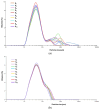Design and Evaluation of a Inonotus obliquus-AgNP-Maltodextrin Delivery System: Antioxidant, Antimicrobial, Acetylcholinesterase Inhibitory and Cytotoxic Potential
- PMID: 40808211
- PMCID: PMC12349574
- DOI: 10.3390/polym17152163
Design and Evaluation of a Inonotus obliquus-AgNP-Maltodextrin Delivery System: Antioxidant, Antimicrobial, Acetylcholinesterase Inhibitory and Cytotoxic Potential
Abstract
Inonotus obliquus, a medicinal mushroom valued for its bioactive compounds, has not been previously characterized from Romanian sources. This study presents the first comprehensive chemical and biological screening of I. obliquus, introducing novel polymer-based encapsulation systems to enhance the stability and bioavailability of its bioactive constituents. Two distinct delivery systems were designed to enhance the functionality of I. obliquus extracts: (i) microencapsulation in maltodextrin (MIO) and (ii) a sequential approach involving preparation of silver nanoparticle-loaded I. obliquus (IO-AgNPs), followed by microencapsulation to yield the hybrid MIO-AgNP system. Comprehensive metabolite profiling using GC-MS and ESI-QTOF-MS revealed 142 bioactive constituents, including terpenoids, flavonoids, phenolic acids, amino acids, coumarins, styrylpyrones, fatty acids, and phytosterols. Structural integrity and successful encapsulation were confirmed by XRD, FTIR, and SEM analyses. Both IO-AgNPs and MIO-AgNPs demonstrated potent antioxidant activity, significant acetylcholinesterase inhibition, and robust antimicrobial effects against Staphylococcus aureus, Bacillus cereus, Pseudomonas aeruginosa, and Escherichia coli. Cytotoxicity assays revealed pronounced activity against MCF-7, HCT116, and HeLa cell lines, with MIO-AgNPs exhibiting superior efficacy. The synergistic integration of maltodextrin and AgNPs enhanced compound stability and bioactivity. As the first report on Romanian I. obliquus, this study highlights its therapeutic potential and establishes polymer-based nanoencapsulation as an effective strategy for optimizing its applications in combating microbial resistance and cancer.
Keywords: Inonotus obliquus; anti-acetylcholinesterase activity; antimicrobial screening; antioxidant potential; in vitro cytotoxicity; micro-spray encapsulation; silver nanoparticles.
Conflict of interest statement
The authors declare no conflicts of interest.
Figures
















Similar articles
-
Design and Evaluation of a Zingiber officinale-Kaolinite-Maltodextrin Delivery System: Antioxidant, Antimicrobial, and Cytotoxic Activity Assessment.Pharmaceutics. 2025 Jun 6;17(6):751. doi: 10.3390/pharmaceutics17060751. Pharmaceutics. 2025. PMID: 40574063 Free PMC article.
-
Biosynthesis and characterization of silver nanoparticles from Asplenium dalhousiae and their potential biological properties.PLoS One. 2025 Jun 30;20(6):e0325533. doi: 10.1371/journal.pone.0325533. eCollection 2025. PLoS One. 2025. PMID: 40587502 Free PMC article.
-
Prescription of Controlled Substances: Benefits and Risks.2025 Jul 6. In: StatPearls [Internet]. Treasure Island (FL): StatPearls Publishing; 2025 Jan–. 2025 Jul 6. In: StatPearls [Internet]. Treasure Island (FL): StatPearls Publishing; 2025 Jan–. PMID: 30726003 Free Books & Documents.
-
A systematic review on natural products with antimicrobial potential against WHO's priority pathogens.Eur J Med Res. 2025 Jul 1;30(1):525. doi: 10.1186/s40001-025-02717-x. Eur J Med Res. 2025. PMID: 40597250 Free PMC article.
-
Natural Products and Health Care Functions of Inonotus obliquus.Curr Issues Mol Biol. 2025 Apr 10;47(4):269. doi: 10.3390/cimb47040269. Curr Issues Mol Biol. 2025. PMID: 40699669 Free PMC article. Review.
References
-
- Glamočlija J., Ćirić A., Nikolić M., Fernandes Â., Barros L., Calhelha R.C., Ferreira I.C., Soković M., Van Griensven L.J. Chemical characterization and biological activity of Chaga (Inonotus obliquus), a medicinal “mushroom”. J. Ethnopharmacol. 2015;162:323–332. doi: 10.1016/j.jep.2014.12.069. - DOI - PubMed
-
- Silva R., Lopes C., Ferreira S., Bernardo M., Bernardo N., Fonseca M. Chaga (Inonotus obliquus) in Healthspan: An Integrative perspective of naturopathy and traditional Chinese medicine. J. Complement. Ther. Health. 2025;3:1–10. doi: 10.5281/zenodo.15263432. - DOI
-
- Peng H., Shahidi F. Bioactive compounds and bioactive properties of chaga (Inonotus obliquus) mushroom: A review. J. Food Bioact. 2020;12:9–75. doi: 10.31665/JFB.2020.12245. - DOI
LinkOut - more resources
Full Text Sources
Research Materials
Miscellaneous

